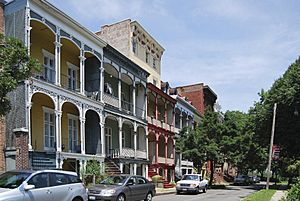Arbor Hill, Albany, New York facts for kids
Quick facts for kids
Arbor Hill
|
|
|---|---|
|
Neighborhood
|
|

Historic housing in the Ten Broeck section of Arbor Hill.
|
|
| Etymology: for a nickname of the Ten Broeck Mansion | |
| Country | United States |
| State | New York |
| County | Albany County |
| City | Albany |
| Settled | 17th century |
| Time zone | UTC-5 (Eastern Standard Time) |
| • Summer (DST) | UTC-4 (Eastern Daylight Time) |
Arbor Hill is a neighborhood in Albany, New York. It stretches from Clinton Avenue north to Tivoli Hollow. It also goes from Broadway west to Henry Johnson Boulevard. Both Clinton Avenue and Henry Johnson Boulevard are part of U.S. Route 9.
This area was not part of Albany's first boundaries in 1686. It was originally called Colonie. In 1804, it became a village. Then, in 1815, it officially joined Albany. Arbor Hill has two smaller areas: Dudley Heights and the Ten Broeck Triangle. The name "Arbor Hill" comes from the Ten Broeck family's estate. The Ten Broeck Mansion is still a major historical museum today. Other important places include the Palace Theatre and St. Joseph's Church. Most people living in Arbor Hill today are African-American.
Contents
History of Arbor Hill
Arbor Hill started as a rural area outside of Albany. It was part of the town of Watervliet. People called this area "the Colonie." In the early 1800s, it became a village.
Later, in 1808, Colonie became its own separate town. However, the people of Colonie and Albany decided to join together. On February 25, 1815, a state law made the town of Colonie part of the city of Albany.
Growth and Changes Over Time
In the 1820s, many workers building the Erie Canal moved to Arbor Hill. By the late 1800s, parts of Arbor Hill, especially the Ten Broeck Triangle, became very fancy. Rich people from the lumber industry lived there.
But by the mid-1900s, Albany's lumber business slowed down. This caused Arbor Hill to face challenges. After the Great Depression, the neighborhood changed. It became a mix of homes and small industrial businesses.
In the early 1900s, many immigrants from Europe, especially Irish-Americans, lived here. Later, during the time of Mayor Erastus Corning II (from 1942 to 1983), many people moved out of the city to the suburbs. This caused the population in Arbor Hill to decrease. By the end of the 1900s, most residents were African-American.
Community Efforts
In 1972, a special police unit was created for Arbor Hill. It helped keep the neighborhood safe. This unit was funded by the government. However, due to budget cuts, the unit eventually closed in 1986.
A new type of school, called a charter school, opened in Arbor Hill in 1999. It was named New Covenant Charter School. This was one of the first charter schools in Albany. It aimed to help students who were struggling. However, the school faced many problems and closed in 2010.
Geography of Arbor Hill
Arbor Hill is located in Albany, New York. It stretches west from Broadway to Henry Johnson Boulevard. It also goes north from Sheridan Hollow to Tivoli Hollow.
 |
West Hill | North Albany Tivoli Hollow |
 |
|
| Broadway | ||||
| Sheridan Hollow | Sheridan Hollow Downtown Albany |
Education in Arbor Hill
Arbor Hill has one public elementary school. It is called Arbor Hill Elementary School. You can find it at 1 Arbor Drive.
Most students at the school are Black (89%). About 5% are Latino, 4% are Multiracial, 1% are White, and 1% are Asian or Pacific Islander. Many students (73%) qualify for free or reduced-price lunch programs. A small number (3%) are learning English. The school's attendance rate is 92%. In 2007, there were 393 students from kindergarten to sixth grade. The average class size was 18 students.

